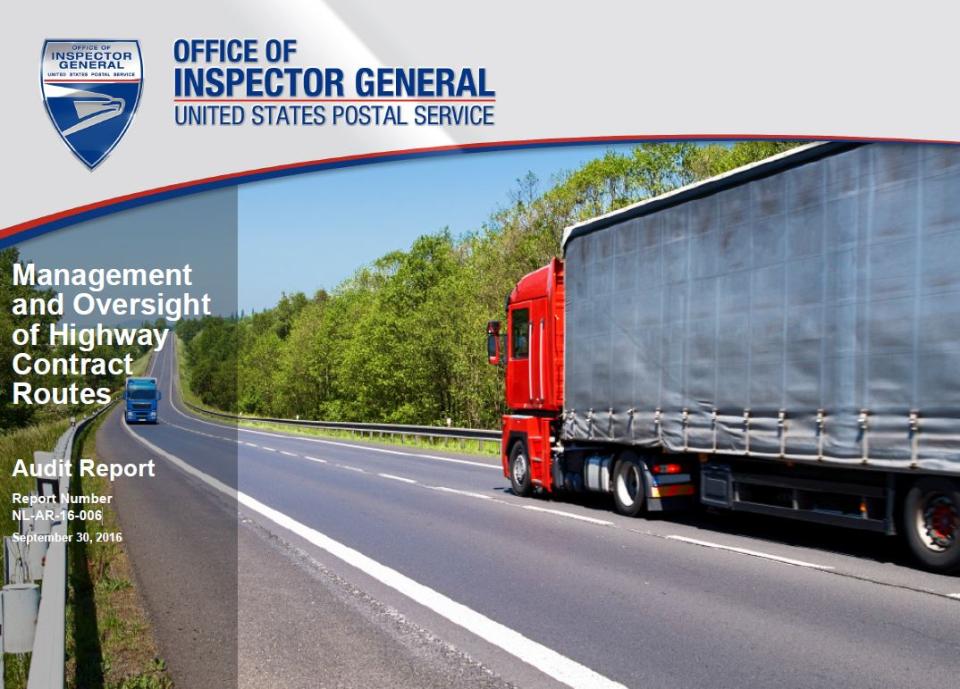Management and Oversight of Highway Contract Routes
Background
The U.S. Postal Service spent about $2.9 billion for about 8,200 highway contract route (HCR) contracts in fiscal year (FY) 2015. As of June 1, 2016, the number of HCR contracts has increased to over 8,300, with a projected annual cost of about $3 billion. HCRs are competitive fixed-price contracts the Postal Service uses to hire contractors to transport mail between post offices and other designated stops.
HCR contracts are the largest single group of contracts in the Postal Service and five nationwide Postal Service Transportation Category Management Teams (TCMT) consisting of about 100 employees manage them. There are 18 contracting officers (CO) responsible for awarding, amending, terminating, and altering transportation contract provisions. In addition, about 80 support staff provides administrative support, assist with contract modifications, and work with suppliers and administrative officials (AO) on contracting activities.
COs work with over 2,100 AOs who are responsible for the daily management and oversight of 8,300 HCR contracts at the local level and for informing COs of any HCR contract performance irregularities.
Our objective was to determine if the Postal Service’s management and oversight of HCRs is efficient and effective.
What the OIG Found
We determined the Postal Service has limited management and oversight of HCR contracts. First, the manual and decentralized HCR irregularity reporting process results in inconsistent reporting. In addition, the HCR Global Positioning System (GPS) and the Logistics Condition Reporting System (LCRS) does not provide accurate management data. Finally, the lack of control over HCR driver photo identification (ID) badges and key cards results in security and access issues.
This is occurring because the Postal Service needs to improve CO and AO span of control. HCR internal controls appear weak because of the limited time available for COs and AOs to manage. The 18 COs at the TCMTs must manage over 8,300 HCR contracts, or an average of 461 contracts per CO, which is approximately 4 hours a year to directly manage each HCR contract.
Each AO locally manages, on average, about four HCR contracts as an additional duty using on the job training and an outdated policy. An AO is generally a postmaster, facility manager, or a designated employee where the HCR originates. Without proper training and guidance, it can be difficult to provide daily contract management and oversight as an additional duty.
For example, AOs manually complete the Contract Route Irregularity Reports to document HCR performance irregularities, such as failure to follow contract schedule, safety violations, unsatisfactory vehicle, or omitted service. The forms are kept in a file and copies are forwarded to the responsible CO. AOs subjectively reported these irregularities, with no direct CO supervision; therefore, because there is no centralized method to manage performance irregularities, one cannot determine if AOs are consistently reporting all contract irregularities.
In addition, the HCR GPS data collected and reported in LCRS is inaccurate and the information is not used to monitor HCR performance. The inaccurate data is due to the incompatibility of contractor GPS technology and the LCRS. The Postal Service has a plan to purchase compatible GPS equipment and anticipates the LCRS will be operational by the end of FY 2017. Without proper reporting and monitoring of HCR contract suppliers’ performance, the Postal Service risks substandard contract services and delayed mail.
Finally, we identified security and control concerns related to HCR driver ID badges and key cards. For example, an HCR contractor with about 1,500 drivers estimated that about 450 to 525 of the drivers, or 30 to 35 percent, have at least two ID badges.
We also determined that HCR drivers could have more than one key card to access postal facilities even if they do not have multiple photo IDs. We estimated that with about 65,000 drivers nationwide, the Postal Service could have issued about 10,000 second badges or key cards to HCR drivers. This increases the cost to the Postal Service and security risks when HCR drivers do not turn in ID badges and key cards when they leave the job permanently.
Current policy does not address drivers having access to multiple facilities or a process to ensure drivers return ID badges and key cards to the Postal Service. We are not making a recommendation concerning this issue because a previous OIG report still has an open recommendation that covers this issue.
The Postal Service has two ongoing HCR initiatives, Dynamic Routing Optimization (DRO) and Zero Base HCR, to reduce transportation costs. The Postal Service is exploring DRO to achieve reductions in HCR and Postal Vehicle Service mileage and fuel costs. Management is using Zero Base HCR to identify excess trailer capacity and reduce duplicative HCR trips. The initiatives are supposed to be complete in November 2016 and September 2017, respectively. These initiatives could provide more efficient and effective HCR management and oversight.
What the OIG Recommended
We recommended management:
- Review and determine the adequacy of the COs’ span of control and the adequacy of the AOs’ oversight of HCRs.
- Develop a centralized process, such as an online spreadsheet, for AOs to report and COs to manage HCR irregularities.
- Implement annual formal training for AOs who report HCR irregularities.
- Update Postal Service Handbook PO-501, HCR Administration, to include required annual HCR training for AOs, enforce the national process for AOs to report and COs to manage HCR irregularities, implement an annual policy review process, and ensure the policy is available on the Postal Service’s PolicyNet.
- Ensure GPS equipment is compatible with the LCRS so that collected HCR performance information is accurate and can be used to manage these contracts and examine opportunities to expand the use of GPS and other electronic data to manage HCR contracts.

